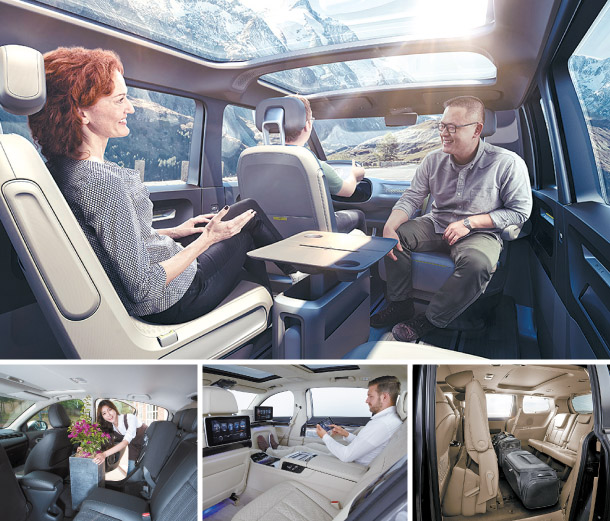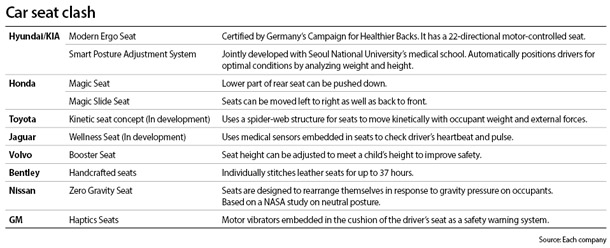Carmakers compete on comfort, versatility

Top: The inside of Volkswagen’s I.D. Buzz. Bottom, from left: The Magic Seat in the Honda HR-V, the BMW 750Li xDrive with extending rear seats and the Kia Carnival’s “Pop-up sinking seats.” [Each company]
Honda’s signature family sedan 2018 Odyssey comes with seats in the middle-row that can move from left to right - as well as the more traditional back to front - just with the pulls of a level, making them much more flexible and versatile. The middle row can also be completely removed if more space is required.
Honda previously introduced its “magic seat” in the HR-V, with rear seats that can fold in three different ways to increase the capacity. With the magic seat, passengers can fold the lower part of the rear seat to almost 90 degrees to make extra room. With its rear-seat design, the Japanese carmaker boasts that up to 126 centimeters (49 inches) of extra storage space can be created with enough clearance room to transport bikes.
Kia’s Carnival has “Pop-up sinking seats” -the fourth row seats can be folded in half and pushed below the floorboard. The hidden seats can be restored with the pull of a lever.
Volkswagen’s I.D. Buzz, which the German carmaker first displayed at the North American International Auto Show in January this year, has a totally flexible seating arrangement. With its battery and motors sitting beneath the floor, the car’s eight-seat cabin can be totally flexible and can feature a lounge-style layout with the front seats able to spin 180 degrees. All of the seating arrangements can be configured with the touch of a button.
While car seat competition mainly focusses on space and gadgetry, some manufacturers have gone back to basics.
Japanese carmaker Nissan is so focused on improving the comfort of their seats that they’ve turned to NASA for inspiration.
Taking insight from a study on neutral posture, Nissan conducted research with Keio University for four years to develop its so-called “Zero Gravity Seats,” which have 14 different pressure points designed to put riders in a neutral position. “The Zero Gravity Seats’ unique shape and patented structure provides continuous support from your hips all the way to your shoulders,” explains the Nissan website, adding that the idea was “inspired by the weightlessness of space” and that it tried to find a “natural position where the least amount of stress is placed on our bones and joints.”

Hyundai Motor Group also introduced its Modern Ergo Seats, which it boasts are certified by Germany’s Campaign for Healthier Backs, in its high-end Genesis EQ 900 model. Korea’s largest automaker introduced a smart body position adjustment system following a joint study with Seoul National University’s medical school in which occupants registered their height and weight so that the system could automatically adjust the seat and steering wheel.
Luxury carmaker Bentley goes one step further to ensure the comfort of its vehicles. The company still hand-stitches each of its leather seats. Each one has more than 5,000 individual stitches and takes as many as 37 hours to complete.
To improve safety for children, Volvo developed its own booster seats for children aged between four and 10 years old and who weight between 33 and 79 pounds. The height of the seats can be adjusted, as well as the side panels and shoulder protection.
BY YUN JUNG-MIN, KANG JIN-KYU [kang.jinkyu@joongang.co.kr]










with the Korea JoongAng Daily
To write comments, please log in to one of the accounts.
Standards Board Policy (0/250자)